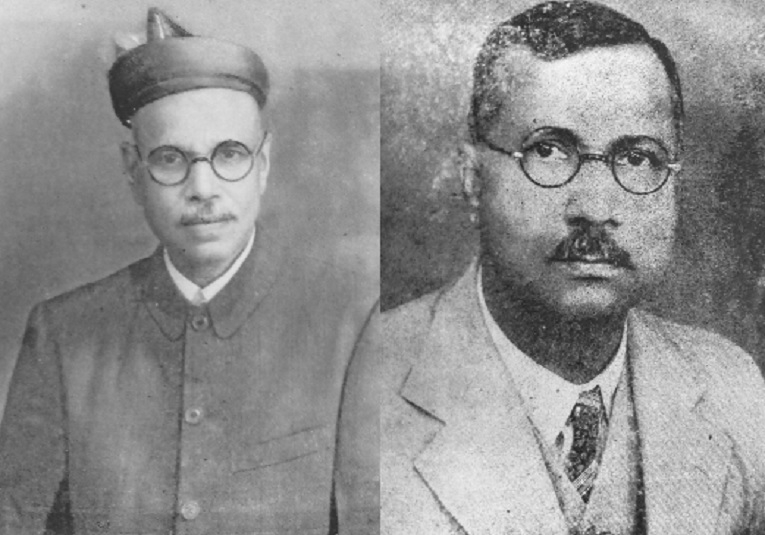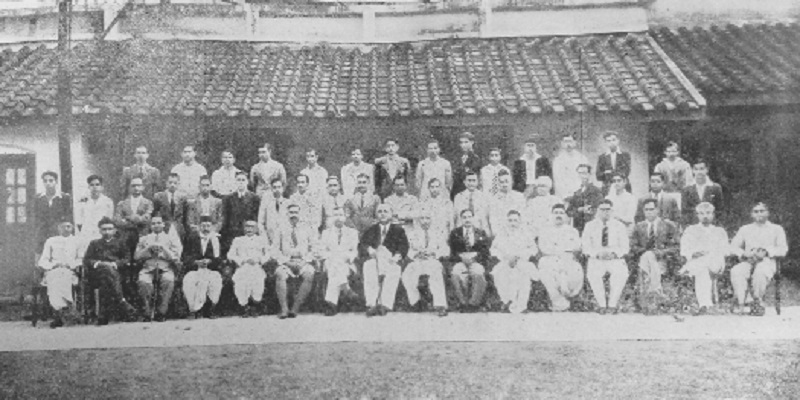Epoch-making commencement at Poona
10 Jan 2020 12:34:57

Mahamahopadhyay Dr P V Kane, President of 13th AIOC held at Nagpur (right) Mahamahopadhyay Prof V V Mirashi, Vice-Chairman of Reception Committee.
By N R Pattarkine :
Nagpur University had a proud privilege to host the 13th AIOC from October 19, through October 21, 1946, just on the threshold of India getting Independence. Initially, this session was to be held at Jaipur but owing to the abnormal time as also the impossibility to accommodate the large number of delegates attending the conference, the mantle fell upon Nagpur University and the burden was borne with commendable care. Sir Fredrick Chalmers Bourne, the Governor of C P & Berar and also the Chancellor of Nagpur University was the patron and Justice W R Puranik, the Vice-Chancellor was the chairman of the Reception Committee.

The conveners and members of Working Committee for 13th AIOC held at Nagpur in October 1946. (Sitting, from left) Prof S G Somalwar (second), Dr S D Pendse (third), Dr Y K Deshpande (fourth), Prof V V Mirashi (seventh), Justice W R Puranik (eighth), Prof V B Kolte (extreme right) and others.
The administrative and academic responsibility of this session was admirably discharged by a great Indologist MM Dr V V Mirashi, Vice-Chairman of the reception committee. The President of this session was Mahamahopadhyaya Dr Pandurang Vaman Kane, an internationally known Indologist. The Nagpur scholar of Prakrit and Jainism Dr Hiralal Jain served as a Local Secretary. The well known Sanskrit orator Prof S G Somalwar composed welcome verses in Sanskrit extolling the qualities of head and heart of MM Dr. Kane, the song being sung by the students of Morris College. In his Presidential speech, at the very outset, Dr Kane paid a glowing tribute to the legal acumen and learning of Justice W R Puranik in a Sanskrit couplet composed by him. Dr Kane expressed a deep sense of admiration for the scholarship of the Presidents of the earlier sessions.
He made some practical suggestions such as the publication of Annual Bibliography and compilation of a Sanskrit Dictionary on Historical principles. He deplored that certain branches of Orientology such as Egyptology and Assyriology have not sufficiently engaged the attention of the scholars. He emphasized the need to encourage the traditional learning of the Shastras. Having realised that the country is now on the threshold of epoch-making political changes and likely to be confronted by the struggle between acceptance of modern innovation and preserving ancient heritage Dr Kane issued a note of caution and care when he said, “She (India) developed centuries ago tradition for tolerance of varying views in religion and philosophy and showed great capacity for absorption of races and ideas and for adaptation. India is now in the midst of whirlpool of ideas.
The present is full of fear, of religious skepticism, conflicts and eagerness to destroy the old and construct a new after some pattern quite alien to our traditions and ways of thought and not yet sufficiently tested. On us of this conference rests a manifold responsibility. It is upto to us not to allow, as long as there is life in us, the great ideals and achievements of the past to be swept off altogether by the onrushing avalanche of conflicting and ill-digested ideas’ (Proceedings P.107). The well-known Indologists of Vidarbha who are now no more with us and who had been associated with the conference administratively, academically and through cultural events included Prof V V Mirashi, Dr Y K Deshpande, Prof S P Chaturvedi, Prof S G Somalwar, Dr G T Deshpande, Dr K L Daftari, T J Kedar, C D Deshmukh, L R Kulkarni, Prof V B Karambalekar, Prof D V Varadpande, M T Sahastrabuddhe, S B Warnekar, Balshastri Hardas.
Dr S D Pendsey, Prof B S Pandit, Prof V B Kolte, Prof S L Katre and others. Many of them served as local secretaries on the various sections. The Pandit Parishad of which the entire deliberations were in Sanskrit was well looked after by Prof S G Somalwar and Balshastri Hardas. The beautifully drafted circular of Pandit Parishad in Sanskrit had formed the part of the proceedings. In consonance with the spirit of the conference to give importance to the promotion of regional languages, three sections namely Marathi, Urdu and Hindi have been operated during the conference. A sizable number of scholars from Vidarbha such as Dr S D Pendsey, Prof V B Kolte, Prof B S Pandit Prof S L Katre along with the scholars like Prof K P Kulkarni, Dr S G Tulpule, G V Tagare, R N Vale and others from Bombay and Poona contributed to make this session a significant one.
A special reference may be made to Prof P S Sastri, then lecturer in English, Chhattisgarh College Raipur, who read two papers one in the ‘Vedic’ section; and other in the ‘Philosophy and Religion’ later became a Nagpurian and served as Head of the Post-Graduate Department of English Literature (1960-1979). He was a profound scholar of English Literature, American Literature and Philosophy and known for his books on ‘Vision of Coleridge’, Rigvedic Aesthetics and Indian Idealism. This conference remained conspicuous by the cultural events that lingered in the memory lane of those who attended this session. The students of the Morris College performed ‘Svapna Vasavadattam’ by Bhasa under the able guidance of the great Sanskrit orator Prof S G Somalwar and Prof N K Diwanji.
The most remarkable part of the performance was that the Sanskrit couplets composed in various rare metres and set to Ragas by Prof S G Somalwar, which epitomised some major scenes, stood to the delectability of the connoisseurs. The two acts of the play ‘Malavikagnimitram’ by Kalidas were presented by the team of SB City College and Nagpur Sanskrit College under the able guidance of Prof D V Varadpande. A tableaux depicting the incidents from Ramayan was presented by the students of Somalwar Academy. On this occasion the exhibition of rare manuscripts and other antiquarian items made available by some eminent families, Bhonsala Residency, some organisations and State Government was arranged for the delegates.
On the administrative side Nagpur session was significant in the sense that Dr R N Dandekar, who till the last session coordinated with Dr A S Aitekar as General Secretary became the sole General Secretary of the conference, the office of which he held till Calcutta session in 1986. Another, major landmarks were the thorough revision of the Rules and Regulations of the conference as originally framed in 4th AIOC at Allahabad (1926) and amended from time to time; as also the registration of the conference under the Society Registration Act XXI of 1860.
The important academic resolution passed was that the AIOC had considered the report of the Central National Museum of Art, Anthropology and Archaeology proposed by the Gwyer Committee and made some recommendations to follow. Two public lecture of general interest were also delivered one on ‘Life values of Sanskrit language and Literature’ by Dr Raghuvir and the other on ‘Kondapur Excavation’ by Khwaja Ahmed. It will not be out of place to say that the Nagpur session of AIOC proved to be landmark in the march of Oriental Scholarship in India. The session was impressive and rich in cultural extravaganza. Thus, things become all the more nostalgic, when Nagpur beckons again and is poised for the centenary celebration of AIOC. (The author is former Secretary of Sanskrit Bhasha Pracharini Sabha, Nagpur) (To be continued)